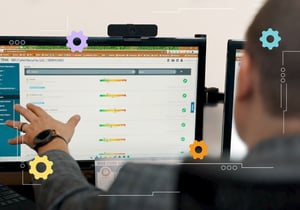Many security professionals know the drill: install a bundle of updates, only to see another round of patches on the horizon. With security-related patches increasing daily, organizations must constantly adapt their patch management process to stay protected.
Why Is Patch Management Important?
Most of us try to keep our bodies healthy by exercising, eating right, washing our hands, and getting enough sleep — habits that prevent viruses and illnesses from compromising our immune systems.
A well-structured patch management program works in a similar way. Patching reduces the number of attack vectors that could compromise infrastructure and data, effectively keeping an organization’s digital environment healthy.
Cyberattacks make headlines almost daily, and unpatched vulnerabilities remain a major risk. In 2024, unpatched software was exploited in approximately 25% of reported breaches. Additionally, the exploitation of vulnerabilities as a primary attack vector increased by 180% year over year, highlighting the growing urgency of timely patching.
Patch Management Challenges
Managing patches isn’t getting easier:
- Patch volume is increasing. In 2024, more than 40,000 common vulnerabilities and exposures (CVEs) were published, marking a 38% increase from the 28,818 reported in 2023.
- Tracking available patches is difficult. Most organizations manage a wide variety of IP-connected devices, any of which could have vulnerabilities.
- Testing is challenging. Smaller organizations often lack a dedicated test environment with the applications and interfaces needed to properly vet patches before deployment.
- Time and staffing are limited. Resource constraints make it difficult for security teams to meet patching demands.
Best Practices for Building an Effective Patch Management Program
Developing an effective patch management program requires careful planning. One of the top priorities is securing management’s involvement in developing and documenting the program. Their full support and commitment are vital to ensuring successful implementation.
The patch management role should also be clearly defined. Larger organizations with dedicated resources may have a specialized team overseeing patches, while smaller organizations often rely on managed service providers (MSPs) to handle updates.
Building a Robust Patch Management Process
Device Inventory for Effective Patch Management
Patching extends beyond PCs, laptops, and servers — any device connected to a network can introduce vulnerabilities.
Internet of things (IoT) devices, including smart TVs, IP surveillance cameras, smart speakers, appliances, and thermostats, all present potential security risks. Keeping a comprehensive inventory of all IP-connected devices ensures no weak links in the patch management process.
Defining Patch Scope Beyond Microsoft Software
Patching shouldn’t focus solely on Microsoft products. Most organizations rely on a range of third-party applications, including Adobe, Java, and Oracle, that also require regular updates.
Beyond software, network hardware such as firewalls, routers, printers, and switches often need firmware updates multiple times a year. Overlooking these critical infrastructure components can leave significant security gaps.
Establishing Patch Frequency
Timing, prioritization, and service-level agreements (SLAs) play a crucial role in the patch management process. The window between identifying a vulnerability and seeing it exploited in the wild has dropped to just five days, a significant decrease from 32 days in previous years.
Organizations should establish clear guidelines on how quickly patches are deployed based on vulnerability criticality. Many use the Common Vulnerability Scoring System (CVSS) to help determine prioritization, though patch urgency should also align with an organization’s specific risk profile.
Not all patches require the same urgency. IT risk assessments can help categorize assets by patching frequency tiers or group them by asset type and vulnerability severity. For example:
- Tier I (critical systems): Patch within 15 days
- Tier III (low-priority assets): Patch within 90 days
Some organizations take this further by tailoring patch timelines to specific asset types and severity levels. The sample matrix below demonstrates how patch timelines can be aligned with CVSS severity ratings and asset criticality. The table also includes a column to help organizations assign accountability for patch management to a system owner. This designation ensures timely patch deployment, improves communication, and supports compliance efforts. System owner assignments are determined internally and will vary depending on the asset and team structure.
| Application | Critical Patch CVSS 9–10 |
High Priority CVSS 7–8.9 |
Medium Priority CVSS 4–6.9 |
System Owner |
| Windows Client | 7 days | 14 days | 30 days | |
| Critical Windows Server | 2 days | 10 days | 20 days | |
| Moderate-Risk Windows Server | 5 days | 15 days | 30 days | |
| Low-Risk Windows Server | 10 days | 20 days | 30 days | |
| Other Applications | 7 days | 14 days | 30 days | |
| Core Banking Application (Locally Hosted) |
Patched based on vendor recommendations and best practices. |
|||
| VoIP Servers/Clients | ||||
| Network Devices | ||||
Sample matrix of patch frequency standards.
This tailored approach helps ensure critical systems are patched quickly while balancing operational workload and risk tolerance across the organization.
Testing Patches Before Deployment
Testing patches before deployment remains one of the top challenges in patch management, particularly for organizations with limited staff and resources.
Every organization should have dedicated testing resources to prevent disruptions. A failed patch could take production systems offline, making predeployment testing essential.
Testing resources might range from a few noncritical production devices for smaller organizations to full lab environments that simulate the full spectrum of applications and interfaces used across the business.
Implementing Patch Rollback Capabilities
Anyone familiar with patch management in cybersecurity has likely encountered a patch that disrupts business operations. In modern network environments, the chances of a security update causing unintended issues are substantial.
A patch rollback plan is essential to quickly reverse problematic patches, minimize downtime, and allow users to continue working without delays.
Managing Cloud/Web Applications in Patch Management
Patching isn’t limited to on-premises systems — cloud and web applications introduce additional complexities. As more applications migrate to software-as-a-service (SaaS) platforms, patching responsibilities often fall to third-party providers.
Organizations should ensure that patching responsibilities and SLAs are clearly outlined in vendor contracts to prevent security gaps in externally hosted applications.
Automating Patch Management
Automating the patch management process with detailed reporting can significantly streamline operations. Patching automation requires the use of a patch management solution, for which many well-respected and proven vendors offer robust, cloud-based systems.
When selecting a patch management tool, it’s important to choose one that supports all applications, not just Microsoft products.
Regular patching reports should also be provided to management, offering visibility into patch status and risk exposure.
Validating Patches
Patch management doesn’t end with deployment — validation ensures vulnerabilities have actually been remediated.
Performing regular vulnerability assessments (VAs) can confirm whether patches were successfully applied. Many organizations use automated vulnerability scanning tools to continuously monitor internal and cloud-based assets.
For internal Microsoft Windows devices, credentialed VAs provide a deeper level of insight, scanning hard drives and registries with administrative credentials. This method uncovers all vulnerabilities, not just surface-level ones detected in uncredentialed scans.
Additionally, some patches require more than just installation to be fully effective. Certain Microsoft security updates, for example, require manual Windows Registry modifications before the vulnerability is truly remediated.
At a minimum, organizations should perform VAs monthly — or continuously, if possible —to stay ahead of emerging threats. Patch validation reports should be reviewed regularly and shared with management to quantify the progress and effectiveness of the patch management process.
The Importance of Proactive Patch Management in Cybersecurity
Patch management is a fundamental component of risk reduction, minimizing an organization’s exposure to cyber threats. Effective cybersecurity patching helps maintain a secure digital environment, shifting organizations from a reactive security mindset to a proactive one.
Regularly assessing the effectiveness of vulnerability identification, remediation, and response processes ensures all key areas are covered.
Organizations have the tools and capabilities to drastically reduce the risk of data breaches, network compromises, and ransomware attacks. While patching requires time and resources, the cost of inaction is far greater.
![]()
Improve Your Patch Strategy

TRAC was built to help you easily demonstrate compliance while also giving you the information you need to make the best decisions for your organization.
Read More
By conducting regular vulnerability assessments as part of your security strategy, you're proactively building a resilient defense that can withstand today's cybersecurity challenges.
Read More


.png?width=400&name=SBSIWebinarsBundles_WebMenu%20(1).png)
